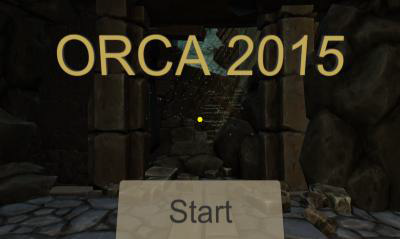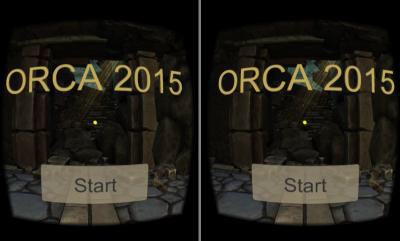Kyle Bryant and Derek Hansen, Information Technology
With Facebook’s recent acquisition of Oculus Rift, the virtual reality (VR) craze has left the den of nerds and tech enthusiasts and gone mainstream. Sony, Steam, and other big name companies’ pledges to develop their own VR platforms have further confirmed the coming of VR to every-home USA. However, this dream may still be far off, with each company’s desires to create its own usually costly and complex solution. All of these companies are not only currently lacking VR experiences to demonstrate, but those that do currently exist require the user to move and interact in the game using a controller, rather than their own feet and hands.
This project began as a simple fascination with the Oculus Rift (the first of many prototype VR solutions). The original goal was to couple indoor positioning systems (IPS) with emerging virtual reality technology to create an experience in which participants could move about in the real world while viewing and interacting with a virtual world – all without suffering from motion sickness, a common side effect of virtual reality. Virtual reality, or the viewing of a two dimensional object with perceived depth, has been around and in use for ages; all it takes is showing two slightly offset images to each eye. However, it has only been within the past years that computer and display equipment has become powerful, small, and cheap enough to offer a Star Trek “Holodeck”-like experience.
Both modern VR and IPS are not without problems. Virtual reality experiences often leave the participant disoriented and suffering from motion sickness due to the perception of movement within the virtual experience but a lack of actual physical movement. IPS have been the holy grail of GPS research for the last ten years without fruit. A major hindrance to the execution of this ORCA project, and to bringing virtual reality into everyday use, was the cost of a VR device and the necessary setup required to make it mobile. In order to get VR into the hands of the everyday user, this project looked towards Google Cardboard1 and an everyday pedometer.
Using Google Cardboard1, an Android smartphone, and Unity 3D, we created a virtual space2,3 in which the player’s movement in real space (tracked via a pedometer in the phone) would move them within the virtual space. This short experience tasked the user to walk around a caved-in dungeon in order to discover the game’s story and the way out. Ten participants were asked to test the experience by wearing the VR headset (Google Cardboard) while walking around a grassy area while under supervision in order to prevent any injuries. The VR test environment consisted of five virtual rooms the participant could explore by walking around in the real world, and free head movement that enabled the participant to look at anything, as facilitated by the smartphone’s orientation tracking. Users could also interact with and read scattered ‘journals’ in the game by toggling the Cardboard’s single button.
Each of the ten participants expressed great excitement after the experience, with many stating it was ‘the most engaging’ experience they have ever had. Seven of the participants stated they do often experience motion sickness when playing any video game, however only one reported mild discomfort while testing the interactive VR. Overall, real walking and immersive in-game sounds pulled the participants out of reality and into the game, which helped to counteract the effects of motion sickness. Many participants mentioned they enjoyed the experience despite their general lack of interest in video games.
While this test was a success, there is much to be improved upon. A majority of participants complained about the initial mismatch of real world steps to in game steps, but promptly adjusted to the system and worked around this complaint. A method to fine-tune and adjust the pedometer to each user’s stride could mitigate this issue. Participants also complained that the game always took a ‘real’ step forward in the direction the player was facing; for example, if the player was walking at 12’o’clock but facing 3’o’clock, the game would believe they were walking and facing 3’o’clock. This issue could be resolved with a separate pedometer apparatus, however, the acquisition, programming, and use of such would prevent many users from simply ‘picking up’ the project. Some participants commented on the lower fidelity of the visuals, yet they found this problem easy to overlook while immersed within the virtual environment.
While use of IPS or higher quality VR headsets (for better visual fidelity and head motion tracking) would be possible, it would come at a much higher cost and require the user to carry additional equipment on their persons, such as a computer and some sort of power supply. The simplicity and availability of smartphones allow the average user to quickly set up and experience virtual reality. Overall, the benefits of a more complex setup do not warrant their exorbitant costs and difficult setup.
While there are still a few problems to solve, this project proved that end users do enjoy physically engaging with a virtual world. This project may be used as a foundation for more advanced VR projects, such as virtual mazes, gripping and personal experiences, or even virtual walkthroughs of far off places- all in the real confines of a small field.

Figure 1 – Google Cardboard. Insert any Android phone with a suitable ‘3D’ app, and enjoy affordable 3D immersion.

Figure 2 – Experience as seen by participants (with depth when used on Google Cardboard)

Figure 3 – How the Google Cardboard displays the experience to the user’s eyes, thus adding depth.
